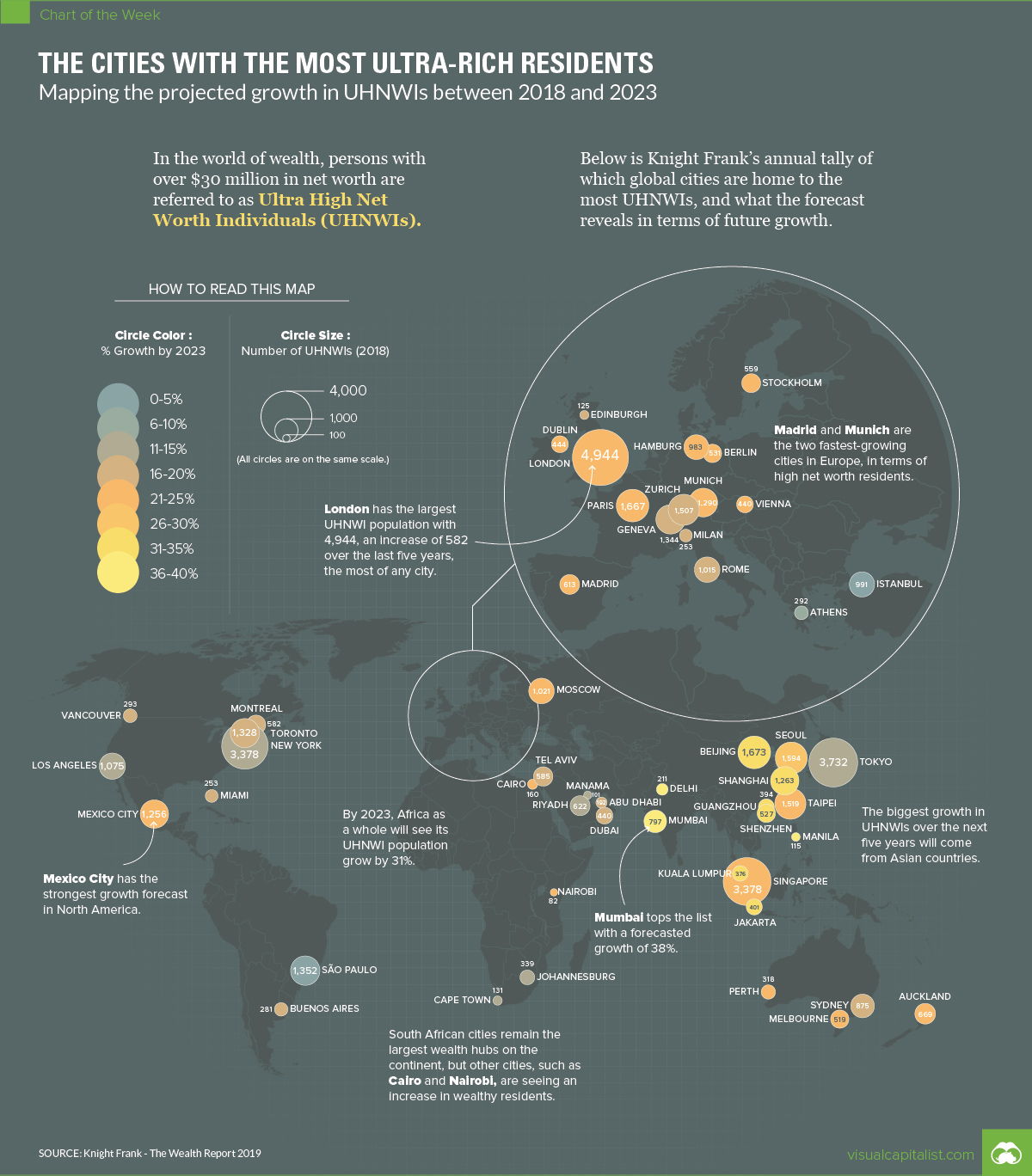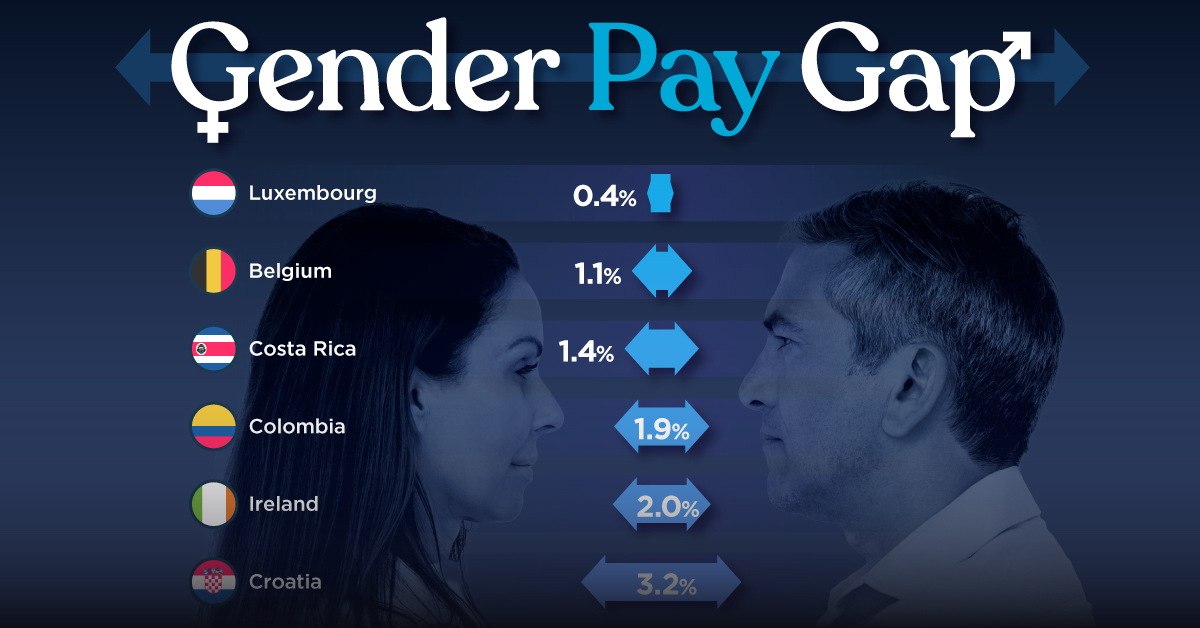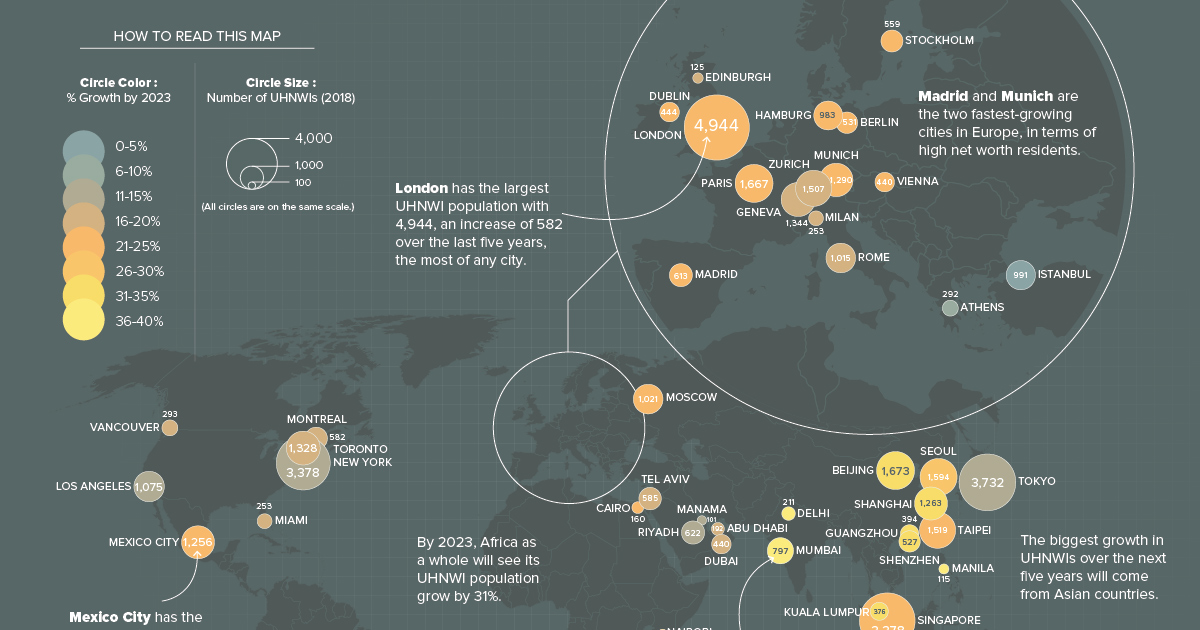Money
Map: Cities With the Most Ultra-Rich Residents

Mapped: The Cities With the Most Ultra-Rich Residents
As of 2018, there is a grand total of 198,342 ultra high net worth individuals (UHNWIs) globally with assets over US$30 million, according to the most recent edition of Knight Frank’s Wealth Report.
Although these millionaires and billionaires can be found all over the globe, the reality is that most of the world’s ultra-rich population tends to congregate in world-class cities.
Generally speaking, UHNWIs are looking to live in places that are conducive to safeguarding and growing their wealth, but that also give them access to top-end amenities that allow them to live comfortably and luxuriously.
Top 10 Cities for the Ultra-Rich
To start, we’ll look at a list of global cities, organized by expected number of UHNWIs in 2023:
| Rank | City | UHNWIs (2018) | UHNWIs (2023e) | Change (%) |
|---|---|---|---|---|
| #1 | 🇬🇧 London | 4,944 | 6,015 | 21.7% |
| #2 | 🇸🇬 Singapore | 3,598 | 4,393 | 22.1% |
| #3 | 🇯🇵 Tokyo | 3,732 | 4,125 | 10.5% |
| #4 | 🇺🇸 New York City | 3,378 | 3,891 | 15.2% |
| #5 | 🇨🇳 Beijing | 1,673 | 2,247 | 34.3% |
| #6 | 🇫🇷 Paris | 1,667 | 2,031 | 21.8% |
| #7 | 🇰🇷 Seoul | 1,594 | 2,020 | 26.7% |
| #8 | 🇹🇼 Taipei | 1,519 | 1,864 | 22.7% |
| #9 | 🇨🇭 Zurich | 1,507 | 1,796 | 19.2% |
| #10 | 🇨🇳 Shanghai | 1,263 | 1,690 | 33.8% |
London continues to top the list, with a roster of 4,944 ultra-rich residents today and the projected growth over the coming years to eclipse the 6,000 mark by 2023.
Tokyo has the second highest amount of UHNWIs today, but the city is adding them at a slower rate than other rival cities. As a result, Singapore will move into the #2 spot overall by 2023, with an expected total of 4,393 high net worth residents.
Finally, it’s worth noting that only two cities on the top 10 list are expected to see growth above a 30% clip over this five-year period. Shanghai and Beijing could be cities to watch for decades to come, as they add millionaires and billionaires at a faster rate than any of the other heavyweights.
Fastest Growing Cities
Where are the billionaire meccas of the future?
Here are the 10 cities that are expected to add UHNWIs the fastest between 2018-2023:
| Rank | City | UHNWIs (2018) | UHNWIs (2023e) | Change (%) |
|---|---|---|---|---|
| #1 | 🇮🇳 Mumbai | 797 | 1,101 | 38.1% |
| #2 | 🇮🇳 Delhi | 211 | 291 | 37.9% |
| #3 | 🇵🇭 Manila | 115 | 157 | 36.5% |
| #4 | 🇨🇳 Shenzhen | 527 | 708 | 34.3% |
| #5 | 🇨🇳 Beijing | 1,673 | 2,247 | 34.3% |
| #6 | 🇨🇳 Guangzhou | 394 | 529 | 34.3% |
| #7 | 🇨🇳 Shanghai | 1,263 | 1,690 | 33.8% |
| #8 | 🇮🇩 Jakarta | 401 | 529 | 31.9% |
| #9 | 🇲🇾 Kuala Lumpur | 376 | 496 | 31.9% |
| #10 | 🇰🇷 Seoul | 1,594 | 2,020 | 26.7% |
Not surprisingly, all 10 of these cities are located in Asia.
Two Indian cities (Delhi and Mumbai) top the list, and are likely to add nearly 40% to their ultra-rich populations over the next five years. China also has a strong showing here.
Interestingly, just missing the above top 10 were a few non-Asian cities: Auckland (#11), Madrid (#12), Munich (#13), and Nairobi (#14) are all expected to grow their UHNWI populations by roughly 25% by 2023.
Demographics
The Smallest Gender Wage Gaps in OECD Countries
Which OECD countries have the smallest gender wage gaps? We look at the 10 countries with gaps lower than the average.

The Smallest Gender Pay Gaps in OECD Countries
This was originally posted on our Voronoi app. Download the app for free on iOS or Android and discover incredible data-driven charts from a variety of trusted sources.
Among the 38 member countries in the Organization for Economic Cooperation and Development (OECD), several have made significant strides in addressing income inequality between men and women.
In this graphic we’ve ranked the OECD countries with the 10 smallest gender pay gaps, using the latest data from the OECD for 2022.
The gender pay gap is calculated as the difference between median full-time earnings for men and women divided by the median full-time earnings of men.
Which Countries Have the Smallest Gender Pay Gaps?
Luxembourg’s gender pay gap is the lowest among OECD members at only 0.4%—well below the OECD average of 11.6%.
| Rank | Country | Percentage Difference in Men's & Women's Full-time Earnings |
|---|---|---|
| 1 | 🇱🇺 Luxembourg | 0.4% |
| 2 | 🇧🇪 Belgium | 1.1% |
| 3 | 🇨🇷 Costa Rica | 1.4% |
| 4 | 🇨🇴 Colombia | 1.9% |
| 5 | 🇮🇪 Ireland | 2.0% |
| 6 | 🇭🇷 Croatia | 3.2% |
| 7 | 🇮🇹 Italy | 3.3% |
| 8 | 🇳🇴 Norway | 4.5% |
| 9 | 🇩🇰 Denmark | 5.8% |
| 10 | 🇵🇹 Portugal | 6.1% |
| OECD Average | 11.6% |
Notably, eight of the top 10 countries with the smallest gender pay gaps are located in Europe, as labor equality laws designed to target gender differences have begun to pay off.
The two other countries that made the list were Costa Rica (1.4%) and Colombia (1.9%), which came in third and fourth place, respectively.
How Did Luxembourg (Nearly) Eliminate its Gender Wage Gap?
Luxembourg’s virtually-non-existent gender wage gap in 2020 can be traced back to its diligent efforts to prioritize equal pay. Since 2016, firms that have not complied with the Labor Code’s equal pay laws have been subjected to penalizing fines ranging from €251 to €25,000.
Higher female education rates also contribute to the diminishing pay gap, with Luxembourg tied for first in the educational attainment rankings of the World Economic Forum’s Global Gender Gap Index Report for 2023.
See More Graphics about Demographics and Money
While these 10 countries are well below the OECD’s average gender pay gap of 11.6%, many OECD member countries including the U.S. are significantly above the average. To see the full list of the top 10 OECD countries with the largest gender pay gaps, check out this visualization.
-

 Mining2 weeks ago
Mining2 weeks agoCharted: The Value Gap Between the Gold Price and Gold Miners
-

 Real Estate1 week ago
Real Estate1 week agoRanked: The Most Valuable Housing Markets in America
-

 Business1 week ago
Business1 week agoCharted: Big Four Market Share by S&P 500 Audits
-

 AI1 week ago
AI1 week agoThe Stock Performance of U.S. Chipmakers So Far in 2024
-

 Misc1 week ago
Misc1 week agoAlmost Every EV Stock is Down After Q1 2024
-

 Money2 weeks ago
Money2 weeks agoWhere Does One U.S. Tax Dollar Go?
-

 Green2 weeks ago
Green2 weeks agoRanked: Top Countries by Total Forest Loss Since 2001
-

 Real Estate2 weeks ago
Real Estate2 weeks agoVisualizing America’s Shortage of Affordable Homes













